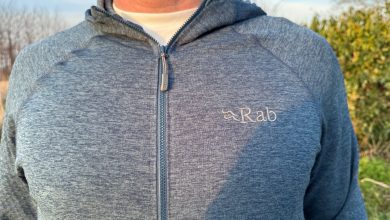Camping food reviews: Eat well, hike easy
A regularly updated post containing reviews of different camping meals.
Before we dive in, here’s a quick overview of the types of food available for campers to buy, plus the merits or otherwise of each:
Types of Camping Food
Over the years I’ve eaten my fair share of camping food/rations. They generally fall somewhere from ‘better than expected under the circumstances’ to ‘really delicious given I’m halfway up a mountain, freezing cold, and haven’t eaten in 36hrs‘. There are too many for me to review fully, though I may do some individual products in the future, but for now, here is an overview of the different broad options available to you for hot food, and the pros and cons of each.
Cook in a pan
I don’t honestly think most ‘serious’ campers do this. Obviously, if you are camping for leisure, cooking up a proper meal from fresh ingredients is fantastic and really satisfying, but if weight is a concern this is a non-starter really.
It might be possible to buy camping foods, especially canned ones, that have to be emptied into a pan and heated, and certainly, any Boil in the Bag (BitB) food could be heated in this way, but it’s not a great approach – adds to washing up without giving any real advantages, and food in BitB retort bags has long overtaken cans for this sort of thing.
Boil in the bag
The staple of British military ration packs and many very similar civilian offerings, this is generally a sealed foil pouch with almost any kind of food inside. It’s put into a mess tin, pan, or jetboil, covered with water, and then heated until the water boils then simmered for a few minutes.
- In general, these can be safely eaten cold (double-check though). The military ones are definitely intended so they can be, and trust me I’ve had a few cold ones. Depending on the food, most aren’t hugely palatable cold but it is fine in a pinch and a massive advantage as if all your food relies on boiling water you potentially have a single point of failure with serious consequences.
- The possible foods are extremely varied, from all-day breakfasts to rice and venison to fish curry, and up to a point they are fairly ‘real’, having been simply prepared, cooked, and packed. That’s a big advantage if you intend to rely on them for more than a few days. They are inevitably a bit mushy though, as a rule.
Disadvantages:
- They are relatively heavy, although it’s all a trade-off, as they don’t use up much water to cook (except that which boils off) and the water they are boiled in can then be used for a hot drink, so it’s not wasted.
- They pretty much have to be heated over a flame (actually they can be heated in a kettle but I didn’t tell you to do that…) which is fine if you are genuinely camping but if you are using these while in semi-hardened accommodation, or in a camper van, there might come a time where you’d rather just boil a kettle…
Rehydrated
These are heated by pouring boiling water in. Generally, they are based on dried/semi-cooked pasta and some kind of sauce, dehydrated as a powder, although you can get other types.
Advantages:
- Being dehydrated, these are lighter than BitB, although you have to factor in carrying water to rehydrate them, so whether they are really lighter depends a lot on your water replenishment plan.
- In my opinion these can be a bit more palatable than endless BitB, as they keep their texture better and the pasta isn’t quite as mushy. All a question of taste, though.
- The big advantage is that they are much simpler to cook, especially if there is a chance of ending up somewhere with a kettle. That might sound odd if you are camping, but it’s happened to me on a few occasions that I slightly unexpectedly find myself somewhere with a really quick and easy source of boiling water. A perfect example is the top of Mt Washington where, as I had dehydrated mac and cheese, I could just pay for a bit of boiling water in the cafe, whereas if I’d had a BitB meal I’d have had to go out into the wind and huddle over my jetboil.
Disadvantages:
- Can be expensive.
- Slightly less variety of food, and tends to taste less ‘real’ since some things just don’t dehydrate well.
- Cannot be eaten cold – absolutely relies on a source of boiling water.
Self-heating
These are similar to BitB foods, but have a water-activated heating pouch. They are used in some US Military ration packs and they obviously have the advantage that all they require is a small amount of cold water – no stove, no fuel, no flame. They do actually get the food remarkably hot if left long enough.
Advantages:
- No need for a stove or open flame, which means they can be cooked almost anywhere, and cuts down on weight (though you may still need a stove to make brews, in which case it might not be much of a saving).
- Very simple to use, no need to worry about stoves, fuel, matches, pans, and so on.
- Food is usually decent – it can be as varied as any BitB meal.
Disadvantages:
- Relatively expensive
- Slightly heavier than other options, though again this is a trade-off depending on how you factor in the need for a stove and water. For an ultralight hiker who doesn’t want a stove but does want hot meals, this could be seen as the super-lightweight option. If you still need a stove for hot drinks, then not so much.
- Generates extra rubbish. Not really a big deal, but it’s a factor.
- Can be harder to get really hot, and no opportunity to give it a quick extra boil if you open it and find it’s still lukewarm.
Now we have that out of the way, let’s dive into some reviews of currently available foods:
Adventure Food Pasta Carbonara
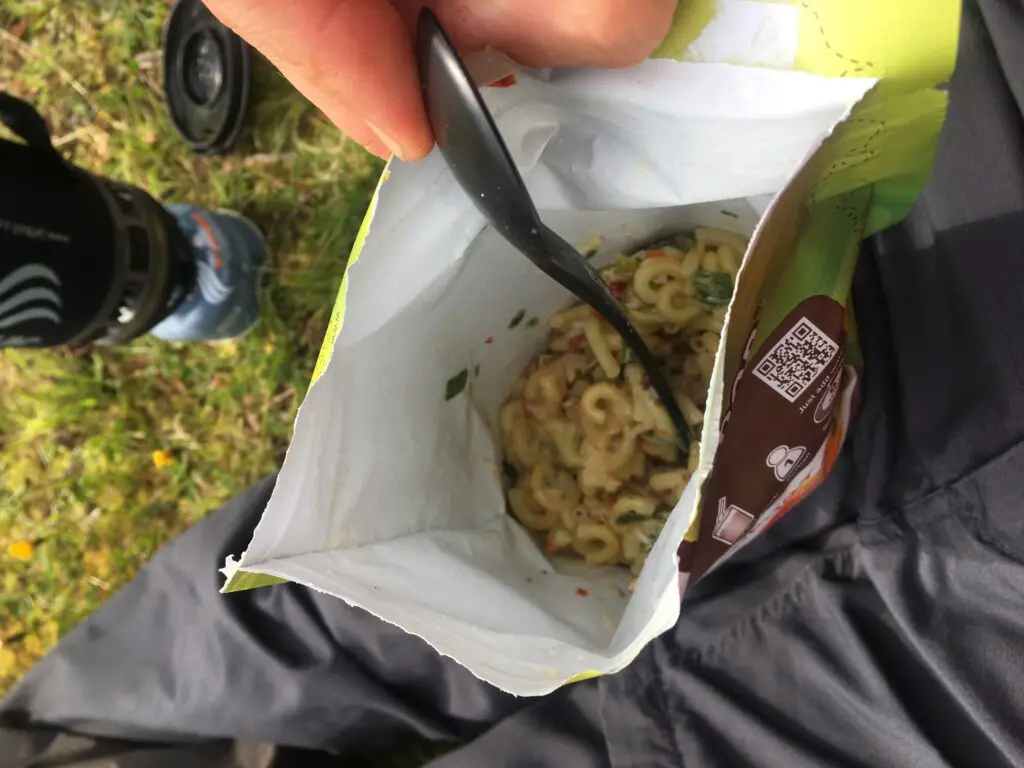
Like most of the meals covered here, this is a dehydrated meal to which you add water. This makes it fairly lightweight and works well with pasta, which keeps its texture much better as a dehydrated meal than as a boil-in-the-bag, where it inevitably goes mushy.
Indeed, the pasta stayed nice and ‘al dente’, which was pretty much the best thing about this meal – in all other respects it was a bit of a disappointment. Carbonara should be dense, creamy, rich, full of bacon, and generally the sort of satisfying comfort food that is absolutely ideal after a long hike. Of course, I didn’t expect the world’s best carbonara, but creamy/cheesy sauces and bacon normally work fairly well as a dehydrated food, so I had reasonably high expectations.
Sadly, Adventure Food decided to be far too clever with this meal and stuffed it with leek and bell pepper, ingredients that have no place in a carbonara. In the end, it tasted of almost nothing but leek and onion, and what little cheese sauce there was barely coated the pasta.
Fine as a way to get calories in, but very disappointing as a meal.
3/10
Expedition Foods Orzo Pasta Bolognese

Another dehydrated meal. This time orzo pasta (little piece of pasta shaped like grains of rize) with bolognese. Again, this sort of thing works brilliantly dehydrated – keeping texture nicely. A really nice meal, rich and filling, and (a minor, but nice given how starving I was at the end of the day…) easy to scoop massive forkfuls of at a time. Like the carbonara, it didn’t seem as if there was all that much sauce, but the chunks of beef were nice and even the pasta on its own was tasty, so the whole meal was enjoyable and didn’t require the same hunting and scraping around for bits of sauce and meat.
A quick note: I originally tested the Expedition Foods option, which is now out of stock. The link above will take you to the equally yummy Firepot offering.
7/10
Mountain House Freeze dried Italian Pepper Steak
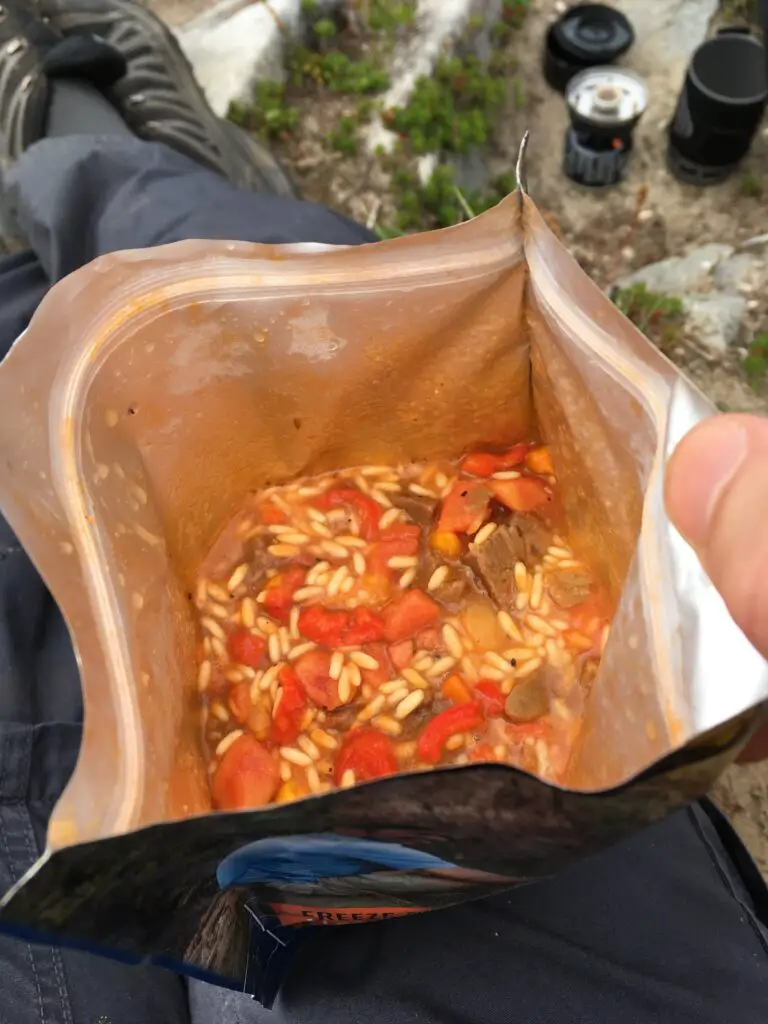
One of several Mountain House meals I had on my recent hike of Section J of the PCT. A good meal with plenty of flavour, nice ‘meaty’ chunks of meat, and discernible vegetable pieces instead of a generic gloopy sauce. Like all of the Mountain House meals I tried, it rehydrated quickly (far more quickly than indicated on the instructions) meaning that it could be eaten while still piping hot, which is a real plus for me.
8/10
Mountain House Freeze Dried Lasagne
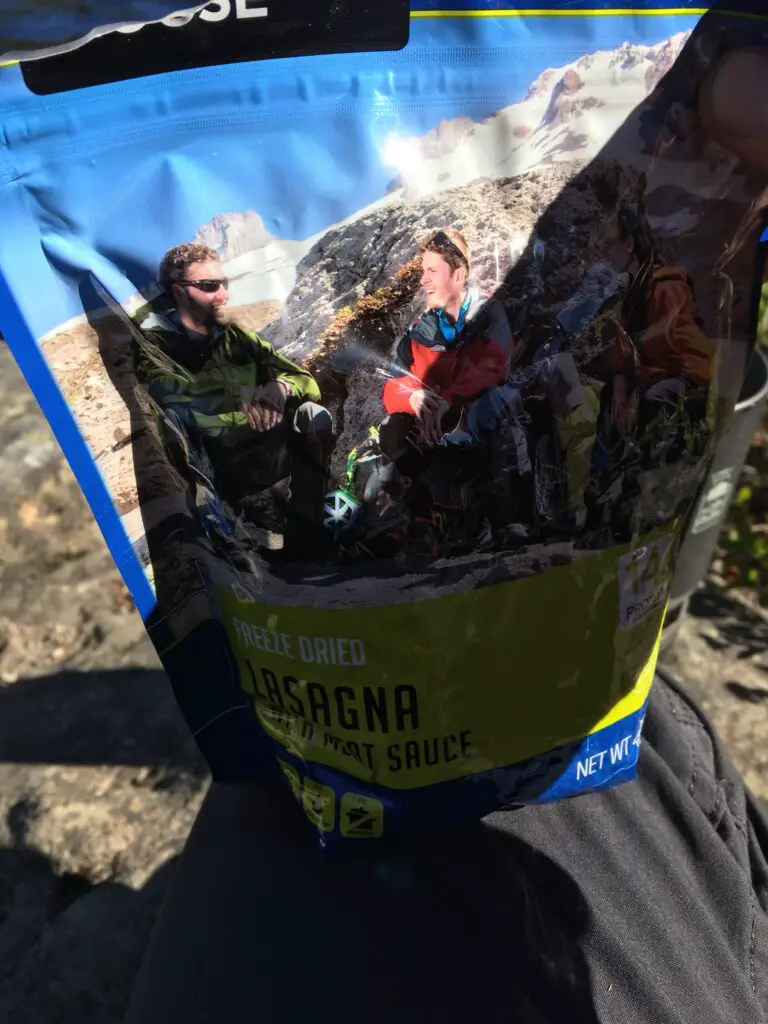
Clearly we were never going to get a properly layered block of lasagne, so I sort of expected this to be just another generic pasta and meat sauce meal. In a way it was, but I was genuinely impressed with Mountain House’s efforts to create something like authentic lasagne. The choice of thin, curved pasta (sorry, forgotten the name of that pasta shape) more or less mimicked sheets of pasta drenched in sauce, and the meat sauce definitely tasted of lasagne not just bolognese.
Most impressive, though, was the cheese – I was genuinely surprised when I first stirred the meal and removed my spark to see a string of elastic cheese being tugged up from the meal. Somehow, the small amount of cheese in the dish retains that kind of stringy, elastic, ‘stick-to-your-fork’ texture of real lasagne and it made all the difference in terms of authenticity and enjoyment.
No pic because I was too busy eating it…
9/10
Mountain House Scrambled Eggs With Bacon
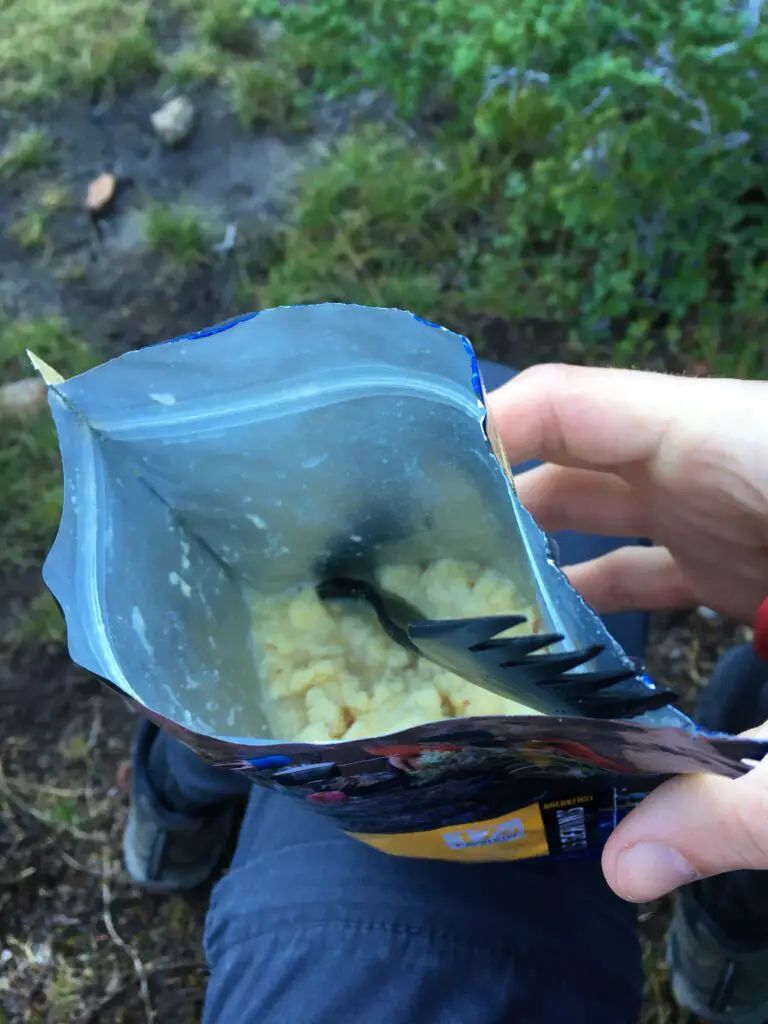
Freeze dried eggs are a breakfast classic and, within reason, they work fairly well. They rehydrate quickly meaning they can be eaten hot, and retain a decent eggy flavour and a slightly dry, chunky texture that is no worse than many bad hotel scrambled eggs I’ve had. The key is to use enough water to rehydrate the eggs fully and avoid chunks that have chewy/crunchy middles but then drain it thoroughly so you don’t end up with egg soup.
The bacon chunks are small, probably too small frankly, and add a bit of flavour but not much else.
6/10
Campfire Meals Scrambled Eggs with Sausage
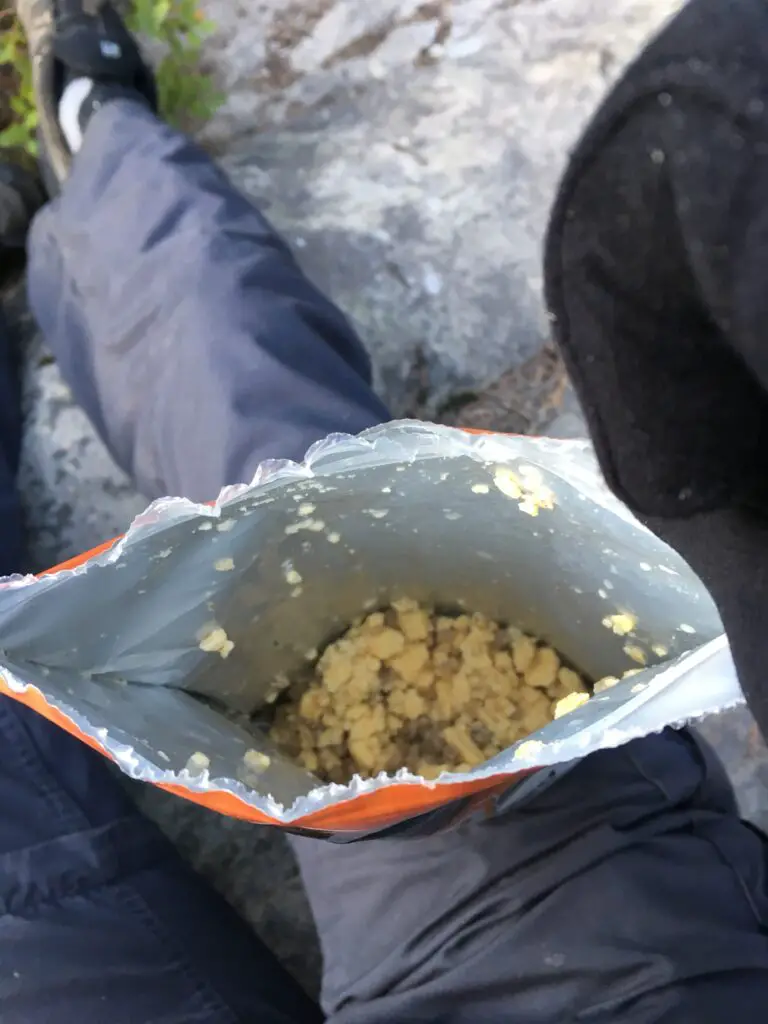
A fairly similar breakfast meal to the Mountain House one above, although the larger chunks of slightly spicy, peppery sausage seemed to make it a more interesting and satisfying breakfast, and one of my favourites overall.
8/10

